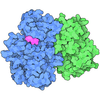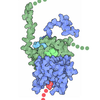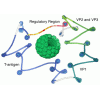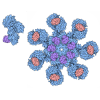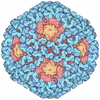+ Open data
Open data
- Basic information
Basic information
| Entry | Database: PDB / ID: 8tar | |||||||||||||||
|---|---|---|---|---|---|---|---|---|---|---|---|---|---|---|---|---|
| Title | APC/C-CDH1-UBE2C-Ubiquitin-CyclinB-NTD | |||||||||||||||
 Components Components |
| |||||||||||||||
 Keywords Keywords | TRANSFERASE / E3 RING Ligase / Ubiquitin Ligase / LIGASE | |||||||||||||||
| Function / homology |  Function and homology information Function and homology informationresponse to DDT / cyclin B1-CDK1 complex / positive regulation of mitochondrial ATP synthesis coupled electron transport / regulation of chromosome condensation / Mitotic Prophase / positive regulation of anaphase-promoting complex-dependent catabolic process / E2F-enabled inhibition of pre-replication complex formation / G2/M DNA replication checkpoint / ventricular cardiac muscle cell development / Depolymerization of the Nuclear Lamina ...response to DDT / cyclin B1-CDK1 complex / positive regulation of mitochondrial ATP synthesis coupled electron transport / regulation of chromosome condensation / Mitotic Prophase / positive regulation of anaphase-promoting complex-dependent catabolic process / E2F-enabled inhibition of pre-replication complex formation / G2/M DNA replication checkpoint / ventricular cardiac muscle cell development / Depolymerization of the Nuclear Lamina / positive regulation of exit from mitosis / free ubiquitin chain polymerization / positive regulation of synapse maturation / MASTL Facilitates Mitotic Progression / regulation of meiotic nuclear division / positive regulation of mRNA 3'-end processing / Conversion from APC/C:Cdc20 to APC/C:Cdh1 in late anaphase / regulation of mitotic cell cycle spindle assembly checkpoint / positive regulation of attachment of spindle microtubules to kinetochore / Inactivation of APC/C via direct inhibition of the APC/C complex / APC/C:Cdc20 mediated degradation of mitotic proteins / Activation of NIMA Kinases NEK9, NEK6, NEK7 / positive regulation of synaptic plasticity / anaphase-promoting complex / patched binding / Phosphorylation of Emi1 / Aberrant regulation of mitotic exit in cancer due to RB1 defects / regulation of meiotic cell cycle / anaphase-promoting complex-dependent catabolic process / metaphase/anaphase transition of mitotic cell cycle / protein branched polyubiquitination / lens fiber cell differentiation / Transcriptional regulation by RUNX2 / tissue regeneration / Phosphorylation of the APC/C / Nuclear Pore Complex (NPC) Disassembly / anaphase-promoting complex binding / regulation of exit from mitosis / outer kinetochore / positive regulation of dendrite morphogenesis / positive regulation of mitotic metaphase/anaphase transition / (E3-independent) E2 ubiquitin-conjugating enzyme / positive regulation of ubiquitin protein ligase activity / exit from mitosis / ubiquitin ligase activator activity / Initiation of Nuclear Envelope (NE) Reformation / Polo-like kinase mediated events / cellular response to fatty acid / Golgi Cisternae Pericentriolar Stack Reorganization / cyclin-dependent protein serine/threonine kinase activator activity / protein K11-linked ubiquitination / Condensation of Prometaphase Chromosomes / digestive tract development / oocyte maturation / regulation of mitotic metaphase/anaphase transition / cyclin-dependent protein serine/threonine kinase regulator activity / ubiquitin-ubiquitin ligase activity / E2 ubiquitin-conjugating enzyme / mitotic metaphase chromosome alignment / mitotic G2 DNA damage checkpoint signaling / ubiquitin conjugating enzyme activity / Regulation of APC/C activators between G1/S and early anaphase / microtubule organizing center / ubiquitin-like protein ligase binding / Transcriptional Regulation by VENTX / negative regulation of cellular senescence / cullin family protein binding / positive regulation of G2/M transition of mitotic cell cycle / enzyme-substrate adaptor activity / ubiquitin ligase complex / response to mechanical stimulus / Chk1/Chk2(Cds1) mediated inactivation of Cyclin B:Cdk1 complex / positive regulation of axon extension / Regulation of MITF-M-dependent genes involved in cell cycle and proliferation / ubiquitin-like ligase-substrate adaptor activity / protein K48-linked ubiquitination / heterochromatin / Cyclin A:Cdk2-associated events at S phase entry / Cyclin A/B1/B2 associated events during G2/M transition / positive regulation of cardiac muscle cell proliferation / intercellular bridge / Nuclear events stimulated by ALK signaling in cancer / positive regulation of mitotic cell cycle / APC/C:Cdc20 mediated degradation of Cyclin B / nuclear periphery / regulation of mitotic cell cycle / APC-Cdc20 mediated degradation of Nek2A / TP53 Regulates Transcription of Genes Involved in G2 Cell Cycle Arrest / Resolution of Sister Chromatid Cohesion / Synthesis of active ubiquitin: roles of E1 and E2 enzymes / Condensation of Prophase Chromosomes / mitotic spindle organization / Autodegradation of Cdh1 by Cdh1:APC/C / APC/C:Cdc20 mediated degradation of Securin / SCF-beta-TrCP mediated degradation of Emi1 / Assembly of the pre-replicative complex / cellular response to iron(III) ion / Cdc20:Phospho-APC/C mediated degradation of Cyclin A / G1/S transition of mitotic cell cycle / G protein-coupled receptor binding Similarity search - Function | |||||||||||||||
| Biological species |  Homo sapiens (human) Homo sapiens (human) | |||||||||||||||
| Method | ELECTRON MICROSCOPY / single particle reconstruction / cryo EM / Resolution: 4 Å | |||||||||||||||
 Authors Authors | Bodrug, T. / Welsh, K.A. / Bolhuis, D.L. / Paulakonis, E. / Martinez-Chacin, R.C. / Liu, B. / Pinkin, N. / Bonacci, T. / Cui, L. / Xu, P. ...Bodrug, T. / Welsh, K.A. / Bolhuis, D.L. / Paulakonis, E. / Martinez-Chacin, R.C. / Liu, B. / Pinkin, N. / Bonacci, T. / Cui, L. / Xu, P. / Roscow, O. / Amann, S.J. / Grishkovskaya, I. / Emanuele, M.J. / Harrison, J.S. / Steimel, J.P. / Hahn, K.M. / Zhang, W. / Zhong, E. / Haselbach, D. / Brown, N.G. | |||||||||||||||
| Funding support |  United States, United States,  Austria, 4items Austria, 4items
| |||||||||||||||
 Citation Citation |  Journal: Nat Struct Mol Biol / Year: 2023 Journal: Nat Struct Mol Biol / Year: 2023Title: Time-resolved cryo-EM (TR-EM) analysis of substrate polyubiquitination by the RING E3 anaphase-promoting complex/cyclosome (APC/C). Authors: Tatyana Bodrug / Kaeli A Welsh / Derek L Bolhuis / Ethan Paulаkonis / Raquel C Martinez-Chacin / Bei Liu / Nicholas Pinkin / Thomas Bonacci / Liying Cui / Pengning Xu / Olivia Roscow / ...Authors: Tatyana Bodrug / Kaeli A Welsh / Derek L Bolhuis / Ethan Paulаkonis / Raquel C Martinez-Chacin / Bei Liu / Nicholas Pinkin / Thomas Bonacci / Liying Cui / Pengning Xu / Olivia Roscow / Sascha Josef Amann / Irina Grishkovskaya / Michael J Emanuele / Joseph S Harrison / Joshua P Steimel / Klaus M Hahn / Wei Zhang / Ellen D Zhong / David Haselbach / Nicholas G Brown /     Abstract: Substrate polyubiquitination drives a myriad of cellular processes, including the cell cycle, apoptosis and immune responses. Polyubiquitination is highly dynamic, and obtaining mechanistic insight ...Substrate polyubiquitination drives a myriad of cellular processes, including the cell cycle, apoptosis and immune responses. Polyubiquitination is highly dynamic, and obtaining mechanistic insight has thus far required artificially trapped structures to stabilize specific steps along the enzymatic process. So far, how any ubiquitin ligase builds a proteasomal degradation signal, which is canonically regarded as four or more ubiquitins, remains unclear. Here we present time-resolved cryogenic electron microscopy studies of the 1.2 MDa E3 ubiquitin ligase, known as the anaphase-promoting complex/cyclosome (APC/C), and its E2 co-enzymes (UBE2C/UBCH10 and UBE2S) during substrate polyubiquitination. Using cryoDRGN (Deep Reconstructing Generative Networks), a neural network-based approach, we reconstruct the conformational changes undergone by the human APC/C during polyubiquitination, directly visualize an active E3-E2 pair modifying its substrate, and identify unexpected interactions between multiple ubiquitins with parts of the APC/C machinery, including its coactivator CDH1. Together, we demonstrate how modification of substrates with nascent ubiquitin chains helps to potentiate processive substrate polyubiquitination, allowing us to model how a ubiquitin ligase builds a proteasomal degradation signal. | |||||||||||||||
| History |
|
- Structure visualization
Structure visualization
| Structure viewer | Molecule:  Molmil Molmil Jmol/JSmol Jmol/JSmol |
|---|
- Downloads & links
Downloads & links
- Download
Download
| PDBx/mmCIF format |  8tar.cif.gz 8tar.cif.gz | 1.5 MB | Display |  PDBx/mmCIF format PDBx/mmCIF format |
|---|---|---|---|---|
| PDB format |  pdb8tar.ent.gz pdb8tar.ent.gz | 1 MB | Display |  PDB format PDB format |
| PDBx/mmJSON format |  8tar.json.gz 8tar.json.gz | Tree view |  PDBx/mmJSON format PDBx/mmJSON format | |
| Others |  Other downloads Other downloads |
-Validation report
| Summary document |  8tar_validation.pdf.gz 8tar_validation.pdf.gz | 1.2 MB | Display |  wwPDB validaton report wwPDB validaton report |
|---|---|---|---|---|
| Full document |  8tar_full_validation.pdf.gz 8tar_full_validation.pdf.gz | 1.2 MB | Display | |
| Data in XML |  8tar_validation.xml.gz 8tar_validation.xml.gz | 166.7 KB | Display | |
| Data in CIF |  8tar_validation.cif.gz 8tar_validation.cif.gz | 292 KB | Display | |
| Arichive directory |  https://data.pdbj.org/pub/pdb/validation_reports/ta/8tar https://data.pdbj.org/pub/pdb/validation_reports/ta/8tar ftp://data.pdbj.org/pub/pdb/validation_reports/ta/8tar ftp://data.pdbj.org/pub/pdb/validation_reports/ta/8tar | HTTPS FTP |
-Related structure data
| Related structure data |  41140MC  8tauC M: map data used to model this data C: citing same article ( |
|---|---|
| Similar structure data | Similarity search - Function & homology  F&H Search F&H Search |
- Links
Links
- Assembly
Assembly
| Deposited unit | 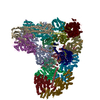
|
|---|---|
| 1 |
|
- Components
Components
-Anaphase-promoting complex subunit ... , 11 types, 13 molecules ACDGWHILMNOYZ
| #1: Protein | Mass: 217566.141 Da / Num. of mol.: 1 Mutation: S202E, S286E, T291E, S313E, T316E, S317E, S334E, S341E, S343E, S355E, S362E, S372E, S377E, T537E, S547E, S555E, S569E, S688E, S699E, S916E, S1347E Source method: isolated from a genetically manipulated source Source: (gene. exp.)  Homo sapiens (human) / Gene: ANAPC1 / Production host: Homo sapiens (human) / Gene: ANAPC1 / Production host:  | ||||||||||||||
|---|---|---|---|---|---|---|---|---|---|---|---|---|---|---|---|
| #3: Protein | Mass: 9854.647 Da / Num. of mol.: 1 Source method: isolated from a genetically manipulated source Source: (gene. exp.)  Homo sapiens (human) / Gene: ANAPC11, HSPC214 / Production host: Homo sapiens (human) / Gene: ANAPC11, HSPC214 / Production host:  | ||||||||||||||
| #4: Protein | Mass: 6556.302 Da / Num. of mol.: 1 Source method: isolated from a genetically manipulated source Source: (gene. exp.)  Homo sapiens (human) / Gene: ANAPC15 / Production host: Homo sapiens (human) / Gene: ANAPC15 / Production host:  | ||||||||||||||
| #5: Protein | Mass: 9920.108 Da / Num. of mol.: 2 / Mutation: S51E, S52E, S82E Source method: isolated from a genetically manipulated source Source: (gene. exp.)  Homo sapiens (human) / Gene: CDC26, ANAPC12, C9orf17 / Production host: Homo sapiens (human) / Gene: CDC26, ANAPC12, C9orf17 / Production host:  #6: Protein | | Mass: 6764.688 Da / Num. of mol.: 1 Source method: isolated from a genetically manipulated source Source: (gene. exp.)  Homo sapiens (human) / Gene: ANAPC16, C10orf104, CENP-27 / Production host: Homo sapiens (human) / Gene: ANAPC16, C10orf104, CENP-27 / Production host:  #7: Protein | | Mass: 92303.305 Da / Num. of mol.: 1 Source method: isolated from a genetically manipulated source Source: (gene. exp.)  Homo sapiens (human) / Gene: ANAPC4, APC4 / Production host: Homo sapiens (human) / Gene: ANAPC4, APC4 / Production host:  #10: Protein | | Mass: 21310.152 Da / Num. of mol.: 1 Source method: isolated from a genetically manipulated source Source: (gene. exp.)  Homo sapiens (human) / Gene: ANAPC10, APC10 / Production host: Homo sapiens (human) / Gene: ANAPC10, APC10 / Production host:  #11: Protein | | Mass: 8528.309 Da / Num. of mol.: 1 Source method: isolated from a genetically manipulated source Source: (gene. exp.)  Homo sapiens (human) / Gene: ANAPC13 / Production host: Homo sapiens (human) / Gene: ANAPC13 / Production host:  #12: Protein | | Mass: 94149.156 Da / Num. of mol.: 1 Source method: isolated from a genetically manipulated source Source: (gene. exp.)  Homo sapiens (human) / Gene: ANAPC2, APC2, KIAA1406 / Production host: Homo sapiens (human) / Gene: ANAPC2, APC2, KIAA1406 / Production host:  #13: Protein | | Mass: 85445.961 Da / Num. of mol.: 1 Source method: isolated from a genetically manipulated source Source: (gene. exp.)  Homo sapiens (human) / Gene: ANAPC5, APC5 / Production host: Homo sapiens (human) / Gene: ANAPC5, APC5 / Production host:  #17: Protein | Mass: 63204.020 Da / Num. of mol.: 2 Source method: isolated from a genetically manipulated source Source: (gene. exp.)  Homo sapiens (human) / Gene: ANAPC7, APC7 / Production host: Homo sapiens (human) / Gene: ANAPC7, APC7 / Production host:  |
-Cell division cycle protein ... , 3 types, 6 molecules JPKSUV
| #8: Protein | Mass: 92519.547 Da / Num. of mol.: 2 Source method: isolated from a genetically manipulated source Source: (gene. exp.)  Homo sapiens (human) / Gene: CDC27, ANAPC3, D0S1430E, D17S978E / Production host: Homo sapiens (human) / Gene: CDC27, ANAPC3, D0S1430E, D17S978E / Production host:  #9: Protein | Mass: 71929.656 Da / Num. of mol.: 2 Source method: isolated from a genetically manipulated source Source: (gene. exp.)  Homo sapiens (human) / Gene: CDC16, ANAPC6 / Production host: Homo sapiens (human) / Gene: CDC16, ANAPC6 / Production host:  #16: Protein | Mass: 69075.133 Da / Num. of mol.: 2 Source method: isolated from a genetically manipulated source Source: (gene. exp.)  Homo sapiens (human) / Gene: CDC23, ANAPC8 / Production host: Homo sapiens (human) / Gene: CDC23, ANAPC8 / Production host:  |
|---|
-Protein , 2 types, 2 molecules QR
| #14: Protein | Mass: 16346.630 Da / Num. of mol.: 1 Source method: isolated from a genetically manipulated source Source: (gene. exp.)  Homo sapiens (human) / Gene: UBE2C / Production host: Homo sapiens (human) / Gene: UBE2C / Production host:  |
|---|---|
| #15: Protein | Mass: 55253.207 Da / Num. of mol.: 1 Source method: isolated from a genetically manipulated source Source: (gene. exp.)  Homo sapiens (human) / Gene: FZR1 / Production host: Homo sapiens (human) / Gene: FZR1 / Production host:  |
-Protein/peptide / Non-polymers , 2 types, 5 molecules B

| #18: Chemical | ChemComp-ZN / #2: Protein/peptide | | Mass: 1284.467 Da / Num. of mol.: 1 / Fragment: NTD (residues 39-50) Source method: isolated from a genetically manipulated source Source: (gene. exp.)  Homo sapiens (human) / Gene: CCNB1, CCNB / Production host: Homo sapiens (human) / Gene: CCNB1, CCNB / Production host:  |
|---|
-Details
| Has ligand of interest | N |
|---|
-Experimental details
-Experiment
| Experiment | Method: ELECTRON MICROSCOPY |
|---|---|
| EM experiment | Aggregation state: PARTICLE / 3D reconstruction method: single particle reconstruction |
- Sample preparation
Sample preparation
| Component | Name: Anaphase-promoting complex/cyclosome in complex with CHD1, UBE2C, and Cyclin-B Type: COMPLEX / Entity ID: #1-#17 / Source: RECOMBINANT |
|---|---|
| Source (natural) | Organism:  Homo sapiens (human) Homo sapiens (human) |
| Source (recombinant) | Organism:  |
| Buffer solution | pH: 8 |
| Specimen | Embedding applied: NO / Shadowing applied: NO / Staining applied: NO / Vitrification applied: YES |
| Vitrification | Cryogen name: ETHANE |
- Electron microscopy imaging
Electron microscopy imaging
| Experimental equipment |  Model: Titan Krios / Image courtesy: FEI Company |
|---|---|
| Microscopy | Model: FEI TITAN KRIOS |
| Electron gun | Electron source:  FIELD EMISSION GUN / Accelerating voltage: 300 kV / Illumination mode: SPOT SCAN FIELD EMISSION GUN / Accelerating voltage: 300 kV / Illumination mode: SPOT SCAN |
| Electron lens | Mode: BRIGHT FIELD / Nominal defocus max: 1500 nm / Nominal defocus min: 200 nm |
| Image recording | Electron dose: 42 e/Å2 / Film or detector model: GATAN K2 BASE (4k x 4k) |
- Processing
Processing
| CTF correction | Type: PHASE FLIPPING AND AMPLITUDE CORRECTION |
|---|---|
| 3D reconstruction | Resolution: 4 Å / Resolution method: FSC 0.143 CUT-OFF / Num. of particles: 661289 / Symmetry type: POINT |
 Movie
Movie Controller
Controller




 PDBj
PDBj